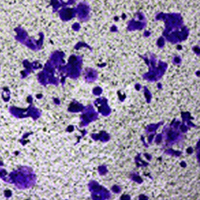LncRNA FGD5-AS1 functions as an oncogene to upregulate GTPBP4 expression by sponging miR-873-5p in hepatocellular carcinoma

Submitted: 2 July 2021
Accepted: 11 October 2021
Published: 16 November 2021
Accepted: 11 October 2021
Abstract Views: 776
PDF: 441
HTML: 27
HTML: 27
Publisher's note
All claims expressed in this article are solely those of the authors and do not necessarily represent those of their affiliated organizations, or those of the publisher, the editors and the reviewers. Any product that may be evaluated in this article or claim that may be made by its manufacturer is not guaranteed or endorsed by the publisher.
All claims expressed in this article are solely those of the authors and do not necessarily represent those of their affiliated organizations, or those of the publisher, the editors and the reviewers. Any product that may be evaluated in this article or claim that may be made by its manufacturer is not guaranteed or endorsed by the publisher.
Similar Articles
- A.T.R. Clark, V.M.L. Guimaraes da Costa, L. Bandeira Costa, C.L. Bezerra Cavalcanti, M.J.B. de Melo Rego, E.I.C. Beltrao, Differential expression patterns of N-acetylglucosaminyl transferases and polylactosamines in uterine lesions , European Journal of Histochemistry: Vol. 58 No. 2 (2014)
- Jiangmu Chen, Zongchi Chen, Weitao Hu, Daxing Cai, Tumor cell-derived exosomal lncRNA LOC441178 inhibits the tumorigenesis of esophageal carcinoma through suppressing macrophage M2 polarization , European Journal of Histochemistry: Vol. 66 No. 4 (2022)
- S. Huang, S. Guo, F. Guo, Q. Yang, X. Xiao, M. Murata, S. Ohnishi, S. Kawanishi, N. Ma, CD44v6 expression in human skin keratinocytes as a possible mechanism for carcinogenesis associated with chronic arsenic exposure , European Journal of Histochemistry: Vol. 57 No. 1 (2013)
- A.K. Lindström, D. Hellberg, Immunohistochemical LRIG3 expression in cervical intraepithelial neoplasia and invasive squamous cell cervical cancer: association with expression of tumor markers, hormones, high-risk HPV-infection, smoking and patient outcome , European Journal of Histochemistry: Vol. 58 No. 2 (2014)
- Xin Kong, Qi Wang, Jie Li, Ming Li, Fusheng Deng, Chuanying Li, Mammaglobin, GATA-binding protein 3 (GATA3), and epithelial growth factor receptor (EGFR) expression in different breast cancer subtypes and their clinical significance , European Journal of Histochemistry: Vol. 66 No. 2 (2022)
- M. Salemi, A. Galia, F. Fraggetta, C. La Corte, P. Pepe, S. La Vignera, G. Improta, P. Bosco, A.E. Calogero, Poly (ADP-ribose) polymerase 1 protein expression in normal and neoplastic prostatic tissue , European Journal of Histochemistry: Vol. 57 No. 2 (2013)
- A. Porzionato, M. Rucinski, V. Macchi, G. Sarasin, L.K. Malendowicz, R. De Caro, ECRG4 expression in normal rat tissues: expression study and literature review , European Journal of Histochemistry: Vol. 59 No. 2 (2015)
- Carlo Pellicciari, Is there still room for novelty, in histochemical papers? , European Journal of Histochemistry: Vol. 60 No. 4 (2016)
- Xiong Bing Li, Jia Li Li, Chao Wang, Yong Zhang, Jing Li, Identification of mechanism of the oncogenic role of FGFR1 in papillary thyroid carcinoma , European Journal of Histochemistry: Vol. 68 No. 3 (2024)
- Wanchun Wang, Jun Yi, Degang Dong, Wenli Mao, Xuanyu Wang, Zhangren Yan, miRNA-877-5p inhibits malignant progression of prostate cancer by directly targeting SSFA2 , European Journal of Histochemistry: Vol. 65 No. 3 (2021)
<< < 1 2 3 4 5 6 7 8 9 10 > >>
You may also start an advanced similarity search for this article.

 https://doi.org/10.4081/ejh.2021.3300
https://doi.org/10.4081/ejh.2021.3300











